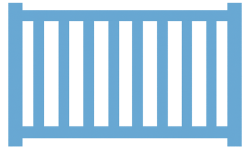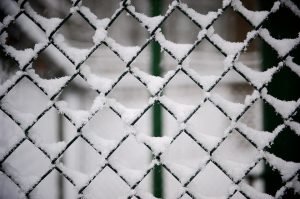Chain link fences are a durable and affordable option for homeowners, but even the sturdiest fence can encounter issues needing repair over time. At Utah Fencing Company, we understand the importance of maintaining your property’s safety and aesthetic appeal. This guide is designed to provide you with effective tips and tricks for Chain Link Fence repair, ensuring your fence remains in top condition. Whether you’re facing minor issues or significant damage, this guide will equip you with the knowledge needed to tackle repairs confidently.
Understanding Chain Link Fence Components
Before diving into repairs, it’s crucial to familiarize yourself with the components of a chain link fence. This knowledge will help you accurately identify the parts needing attention and streamline the repair process. Chain link fences consist of fabric, posts, rails, and often, tension wires and gates. Each plays a vital role in the fence’s overall stability and functionality.
When inspecting your fence for damage, assess each component carefully. Damage to the posts and rails can compromise the fence’s structural integrity, while issues with the fabric might impact its security function. Understanding these elements will guide you in determining the necessary repairs.
Common Chain Link Fence Issues
Chain link fences are susceptible to various types of damage, from rust and corrosion to sagging and bending. Environmental factors, such as harsh weather conditions and accidental impacts, contribute to these common issues. Recognizing the signs of damage early can prevent more extensive, costlier repairs down the line.
Rust is one of the most frequent problems, especially in areas with high moisture levels. Sagging sections and bent rails or posts can result from physical impact or the ground shifting over time. Addressing these problems promptly will help maintain your fence’s appearance and functionality.
Essential Tools for DIY Fence Repair
Having the right tools on hand is essential for any successful DIY repair project. For chain link fence repairs, you’ll need a set of basic tools that are likely already in your home workshop. These include pliers, a wire cutter, a wrench, and a come-along winch for tensioning. Depending on the extent of the repair, you might also need Concrete and a posthole digger for post repairs.
Investing in high-quality tools ensures efficiency and safety while working on your fence repairs. Always wear protective gloves and eyewear to safeguard against injuries. With the proper tools and precautions, you’re well on your way to successfully repairing your chain link fence.
Step-by-Step Guide to Repairing Fence Fabric
One of the most common repair tasks is fixing damaged fence fabric. Start by assessing the extent of the damage. If it’s a small hole or tear, you might be able to mend it using a fence repair kit. For larger areas of damage, replacing a section of the fabric could be necessary.
Begin by removing the damaged section of fabric by untwisting or cutting the wire ties that attach it to the posts and rails. Then, cut a piece of replacement fabric to size and attach it to the existing fence using ties or wire. Ensure that the new section is pulled tight and securely fastened to prevent sagging.
Fixing Leaning Posts and Rails
Leaning posts or rails can significantly affect your fence’s structural integrity. The cause is often due to loosened post foundations or damage to the posts themselves. Start by assessing whether the post can be straightened and reinforced or if it needs replacing.
If the post can be saved, temporarily remove the fence fabric attached to it. Use a shovel or posthole digger to expose and straighten the post, then add or replace concrete to secure it. If the post is irreparably damaged, it will need to be replaced. Remember to let any new concrete set fully before reattaching the fence fabric.
Maintenance Tips to Prevent Future Repairs
Preventative maintenance is key to extending the life of your chain link fence and minimizing future repairs. Regular inspections can catch issues before they become major problems. Keep an eye out for signs of rust, sagging sections, or loose posts and rails.
Cleaning your chain link fence annually helps prevent rust and corrosion. Use a mild soap and water solution to remove dirt and grime. For areas showing signs of rust, use a wire brush to scrub the affected areas gently, then apply a rust-inhibitor product. These maintenance steps will keep your fence looking new and functional for years to come.
Important Safety Considerations
When undertaking any repair project, safety should always be your top priority. Wear appropriate protective gear, including gloves and safety goggles, to protect against cuts and eye injuries. If you’re working near electrical lines or uncertain about your ability to safely complete a repair, consider hiring a professional.
Additionally, ensure that your repair methods comply with local regulations and building codes. This is particularly important if your fence serves as a pool barrier or is subject to specific community standards. When in doubt, consulting with a professional fencing company can provide peace of mind and ensure that your repairs are safe and effective.
Determining When to Call a Professional
While many chain link fence repairs can be straightforward DIY projects, there are situations when calling a professional is the best course of action. If you’re facing extensive damage, issues with posts set in concrete, or repairs that require specialized tools, professional services might be necessary.
A professional fencing company has the expertise and equipment to handle complex repairs efficiently and safely. This ensures that your fence is restored to its optimal condition, providing security and aesthetics to your property. Remember, investing in professional repairs can save time and money in the long run by preventing further damage.
5 Key Components to Regularly Inspect
- Fence Fabric: Check for tears, holes, or signs of rust. Early detection of fabric damage can prevent the need for more extensive repairs.
- Posts and Rails: Ensure they are straight and securely anchored. Check for signs of rust, rot (for wooden posts), or other damage.
- Hardware: Inspect all clips, ties, and fasteners. Replace any that are damaged or missing to maintain fence stability.
- Gates: Check for smooth operation and secure closure. Lubricate hinges and replace damaged components as needed.
- Surrounding Area: Keep the area around your fence clear of debris and vegetation. This can prevent damage and make inspections easier.
Conclusion
Maintaining your chain link fence through regular inspections and timely repairs is essential for ensuring its longevity and functionality. With these tips and tricks, you’re well-equipped to address common repair needs, preserving the security and aesthetics of your property. For more extensive repairs or for professional advice, don’t hesitate to reach out to us at Utah Fencing Company by phone at 801-905-8153 or Request a Free Quote.




